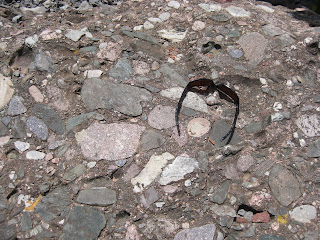Last week we saw our first major accumulation of snow. In some places there were reports of four feet! Not so much here, but a blue sky day and new snow that was just aching to be skied on. We climbed up into the basin, and noticed very few ski tracks and a few recent avalanche paths, including this one large slide.
 The crown fracture line was just a few feet deep. You can see the major slide and then a smaller sympathetic slide right next door.
The crown fracture line was just a few feet deep. You can see the major slide and then a smaller sympathetic slide right next door. The debris crossed the valley, all the way to the small drainage.
The debris crossed the valley, all the way to the small drainage. A little over exposed (I don't know who left the setting at 1600ISO?) But this gives a better idea of the size of the event. We skied a little closer and then turned around and went someplace safer.
A little over exposed (I don't know who left the setting at 1600ISO?) But this gives a better idea of the size of the event. We skied a little closer and then turned around and went someplace safer.















































